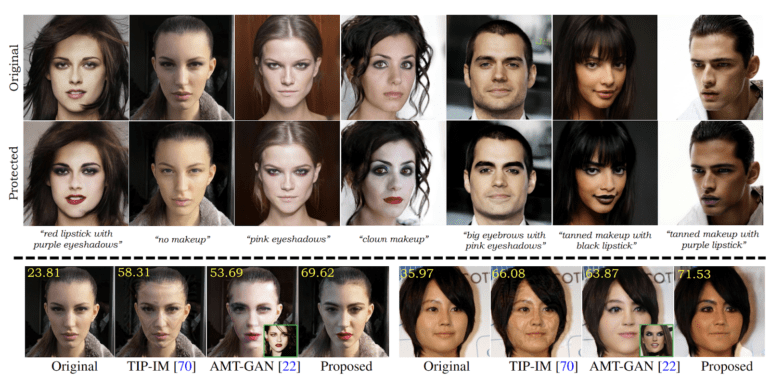TL;DR:
- Face recognition technology has made significant advancements, raising concerns about privacy.
- The research community has been actively developing facial privacy protection algorithms.
- CLIP2Protect is a novel approach that uses generative models and textual prompts for facial privacy protection.
- It maintains the balance between preserving privacy and maintaining the visual fidelity of protected images.
- CLIP2Protect effectively hides attack information within desired makeup styles without relying on extensive datasets or retraining.
- Extensive experiments demonstrate CLIP2Protect’s efficacy against black-box face recognition models and online recognition APIs.
Main AI News:
In the realm of 90s sci-fi movies, we were captivated by the idea of computers unveiling intricate profiles of individuals, providing a wealth of information at a glance. Back then, this face-recognition technology seemed like a distant dream, reserved for the realm of fiction. However, today, we find ourselves living in a reality where advanced face recognition systems have become a powerful force, raising concerns about our privacy in an increasingly connected world.
The march of progress cannot be halted, and the field of deep learning has propelled face recognition technology to unprecedented heights. This technological breakthrough has revolutionized countless industries and applications, leaving us to ponder whether the outcome is beneficial or detrimental. Regardless, the undeniable truth is that our facial features have become gateways to a trove of personal information. In this landscape, safeguarding our privacy becomes paramount.
To address these concerns head-on, the research community has dedicated significant efforts to exploring methods and techniques that can protect our facial privacy. These pioneering algorithms aim to strike a delicate balance, preserving our anonymity while ensuring the usability and visual fidelity of our facial images. Shielding individuals from unauthorized identification or tracking is the primary objective, but it is equally crucial to thwarting attempts to deceive the system with counterfeit faces.
Achieving this equilibrium is no easy task, particularly when employing noise-based approaches that overlay adversarial artifacts onto the original face image. Although various methodologies have been proposed to generate unrestricted adversarial examples, makeup-based techniques have emerged as the most prominent. These methods excel at embedding adversarial modifications in a natural manner. However, they suffer from limitations such as the presence of makeup artifacts, reliance on reference images, the necessity of retraining for each target identity, and a focus on impersonation rather than privacy preservation.
Consequently, the need for a robust and reliable facial privacy protection method becomes apparent. Enter CLIP2Protect, a groundbreaking solution poised to redefine online security.
CLIP2Protect introduces a novel approach to safeguarding user facial privacy on online platforms. At its core, it revolves around the quest for adversarial latent codes within a low-dimensional manifold, which is learned by a generative model. These latent codes unlock the ability to generate high-quality face images that faithfully preserve the individual’s identity while simultaneously outwitting black-box face recognition systems.
A crucial element of CLIP2Protect lies in its utilization of textual prompts to facilitate adversarial makeup transfer. By leveraging this technique, the generative model’s latent manifold can be traversed, uncovering transferable adversarial latent codes. This groundbreaking approach allows the attack information to be concealed within the desired makeup style, all without the need for extensive makeup datasets or retraining for various target identities. Additionally, CLIP2Protect incorporates an identity-preserving regularization technique, guaranteeing that the protected face images bear a striking resemblance to their original counterparts.
The efficacy of CLIP2Protect has been put to the test through extensive experiments, evaluating its performance in face verification and identification scenarios. The results speak volumes, showcasing its ability to thwart black-box face recognition models and online commercial facial recognition APIs.
Conclusion:
The emergence of CLIP2Protect as an AI-powered solution for facial privacy protection signifies a significant breakthrough in the market. As concerns regarding facial recognition technology and privacy intensify, businesses and individuals are seeking reliable methods to safeguard personal information. CLIP2Protect addresses this demand by offering a sophisticated approach that strikes a delicate balance between privacy preservation and visual fidelity. By leveraging generative models and textual prompts, it presents a natural and effective way to conceal attack information within desired makeup styles.
Furthermore, its compatibility with diverse target identities without the need for extensive retraining or reliance on reference images sets it apart from existing techniques. The extensive experiments highlighting its efficacy against black-box face recognition models and online recognition APIs solidify CLIP2Protect’s position as a game-changer in the market. As businesses navigate the landscape of privacy concerns and regulations, adopting cutting-edge solutions like CLIP2Protect becomes essential to ensure the protection of personal data and maintain consumer trust.

